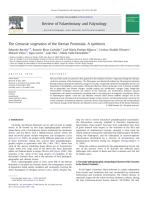A synthesis on the Cenozoic vegetation in the Iberian Peninsula

The aim of this work is to provide a first approach to the evolution of Iberia's vegetation during the Cenozoic (with the exclusion of the Quaternary).
The Palaeogene was floristically defined by Palaeotropical elements forming tropical/subtropical rainforests, mangrove swamps, edaphically-mediated laurophyllous forests and leguminous-sclerophyllous communities.
During the Miocene, Iberian landscapes were drastically modified due to geographic and climatic changes (mainly cooling and aridification) changes. Open, steppe-like environments developed towards the interior of the peninsula and Arctotertiary elements invaded mountainous and riparian ecosystems, coexisting with or becoming part of evergreen, broadleaved forests of Palaeotropical species.
From the Late Miocene onwards these forests suffered changes due to the extinction of taxa, the impact of environmental change on the survivors, and the perturbations caused by the arrival of further Arctotertiary elements. However, several Palaeotropical taxa overcame the environmental and climatic changes of the Miocene and Pliocene to form a part of the modern flora of the Iberian Peninsula.







